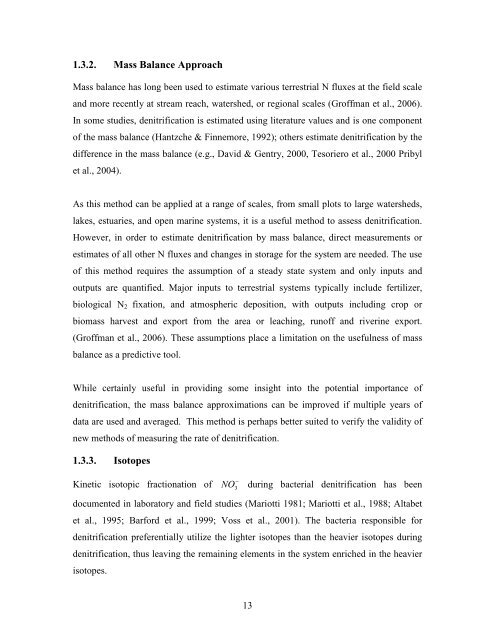THE FLORIDA STATE UNIVERSITY ARTS AND SCIENCES ...
THE FLORIDA STATE UNIVERSITY ARTS AND SCIENCES ...
THE FLORIDA STATE UNIVERSITY ARTS AND SCIENCES ...
Create successful ePaper yourself
Turn your PDF publications into a flip-book with our unique Google optimized e-Paper software.
1.3.2. Mass Balance Approach<br />
Mass balance has long been used to estimate various terrestrial N fluxes at the field scale<br />
and more recently at stream reach, watershed, or regional scales (Groffman et al., 2006).<br />
In some studies, denitrification is estimated using literature values and is one component<br />
of the mass balance (Hantzche & Finnemore, 1992); others estimate denitrification by the<br />
difference in the mass balance (e.g., David & Gentry, 2000, Tesoriero et al., 2000 Pribyl<br />
et al., 2004).<br />
As this method can be applied at a range of scales, from small plots to large watersheds,<br />
lakes, estuaries, and open marine systems, it is a useful method to assess denitrification.<br />
However, in order to estimate denitrification by mass balance, direct measurements or<br />
estimates of all other N fluxes and changes in storage for the system are needed. The use<br />
of this method requires the assumption of a steady state system and only inputs and<br />
outputs are quantified. Major inputs to terrestrial systems typically include fertilizer,<br />
biological N2 fixation, and atmospheric deposition, with outputs including crop or<br />
biomass harvest and export from the area or leaching, runoff and riverine export.<br />
(Groffman et al., 2006). These assumptions place a limitation on the usefulness of mass<br />
balance as a predictive tool.<br />
While certainly useful in providing some insight into the potential importance of<br />
denitrification, the mass balance approximations can be improved if multiple years of<br />
data are used and averaged. This method is perhaps better suited to verify the validity of<br />
new methods of measuring the rate of denitrification.<br />
1.3.3. Isotopes<br />
Kinetic isotopic fractionation of<br />
−<br />
NO 3 during bacterial denitrification has been<br />
documented in laboratory and field studies (Mariotti 1981; Mariotti et al., 1988; Altabet<br />
et al., 1995; Barford et al., 1999; Voss et al., 2001). The bacteria responsible for<br />
denitrification preferentially utilize the lighter isotopes than the heavier isotopes during<br />
denitrification, thus leaving the remaining elements in the system enriched in the heavier<br />
isotopes.<br />
13
















